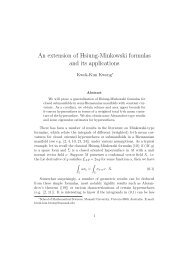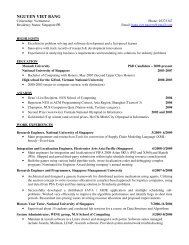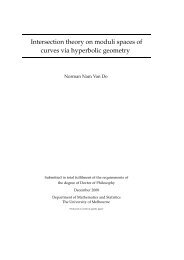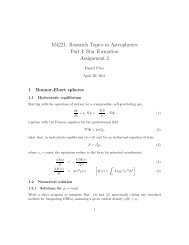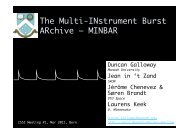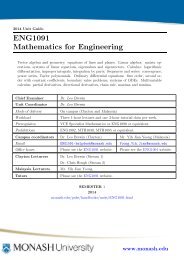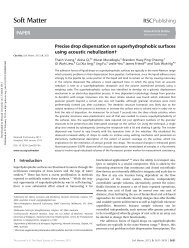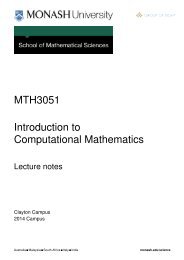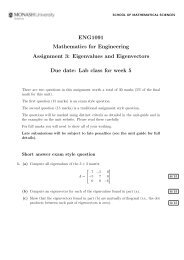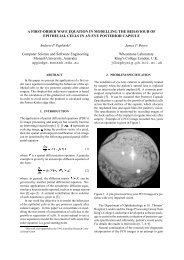MTH3051 Intro. to Computational Mathematics - User Web Pages ...
MTH3051 Intro. to Computational Mathematics - User Web Pages ...
MTH3051 Intro. to Computational Mathematics - User Web Pages ...
You also want an ePaper? Increase the reach of your titles
YUMPU automatically turns print PDFs into web optimized ePapers that Google loves.
2014 Unit Guide<strong>MTH3051</strong><strong>Intro</strong>. <strong>to</strong> <strong>Computational</strong> <strong>Mathematics</strong>The unit offers a practical introduction <strong>to</strong> numerical computing. It begins by introducingthe computing package MATLAB which is widely used in science and engineering. MAT-LAB will be the basis for all teaching and practical work. Topics covered include erroranalysis, the solution of algebraic equations; approximations of functions: curve fitting,least squares and interpolation; analysis of data by Fourier Transforms and FFTs; numericaldifferentiation and integration; ordinary differential equations. These <strong>to</strong>pics will besupported with case studies drawn from various disciplines in the physical sciences.Chief ExaminerUnit Coordina<strong>to</strong>rMode of deliveryWorkloadPrerequisitesProhibitionsLecturerDr. Leo BrewinDr. Leo BrewinOn campusThree 1-hour lectures and one 2-hour tu<strong>to</strong>rial class per weekMTH1030 or MTH1035MTH2051Dr. Leo BrewinPhone 9905 4456EmailOffice hoursTu<strong>to</strong>rsLeo.Brewin@monash.eduPlease see the <strong>MTH3051</strong> website.Please see the <strong>MTH3051</strong> website.SEMESTER 12014monash.edu/pubs/handbooks/units/<strong>MTH3051</strong>.htmlwww.monash.edu
1. Academic Overview1.1 Learning OutcomesOn completion of this unit students will be able <strong>to</strong>:◮ Use a computer as a <strong>to</strong>ol <strong>to</strong> solve mathematical problems using a simple butpowerful package such as MATLAB.◮ Understand how algorithms can be used <strong>to</strong> translate from mathematics in<strong>to</strong> MAT-LAB programs.◮ Demonstrate that there are a variety of ways <strong>to</strong> solve a numerical problem.◮ Recognise the strengths and weaknesses of alternative algorithms.◮ Select the appropriate algorithm for the problem at hand.◮ Understand the approximations introduced in algorithms and the effects that thoseapproximations have on the quality of calculations.1.2 Unit scheduleWeek Lecture <strong>to</strong>pic ReferencePART I: INTRODUCTION.1 <strong>Intro</strong>duction <strong>to</strong> Matlab.2 Truncation and Round-off errors.PART I: LINEAR AND NON-LINEAR EQUATIONS.3 Solutions of non-linear equations in one variable.4 Solutions of linear systems of equations.5 Solutions of non-linear systems of equations.PART II: FUNCTION APPROXIMATION.6 Polynomial Interpolation. Cubic splines. Fourier series.PART III: INTEGRATION AND DIFFERENTIATION.7 Richardson extrapolation.8 Definite integrals and Romberg integratioin.PART III: INTEGRATION AND DIFFERENTIATION.9 Numerical differentiation. Finite differences and numerical errors.10 Numerical solutions of ordinary differential equations.PART IV: OPTIMIZATION AND RANDOM NUMBERS11 Optimization methods. Golden search and Genetic Algorithms.12 Computer generated random numbers.REVISION AND EXAM PREPARATION16-Feb-2014 2
1.3 Assessment summaryAssessment task Value Due in weekAssignment 1: Long multiplication. 6% 4Assignment 2: Root finding. 6% 5Assignment 3: Reccurence relations and Bessel functions. 6% 7Assignment 4: Estimating √ 7 using continued fractions. 6% 9Assignment 5: Implicit integration. 6% 112. Teaching ApproachIn the first week of the semester there will be just three one-hour lectures. For the remainderof the semester (weeks 2 <strong>to</strong> 12) there will be three one-hour lectures plus one two hour tu<strong>to</strong>rial(also known as a support, practice or labora<strong>to</strong>ry class).2.1 LecturesThe material in lectures will be presented by hand – a live human (me) will create real mathematicsbefore your eyes. The material will based on a printed set of lecture notes, includinglab class exercises, will be made available through the bookshop and as PDF file on the unitwebsite. You are expected <strong>to</strong> bring these notes <strong>to</strong> lectures and tu<strong>to</strong>rials. The lectures will berecorded (audio only) and will be available from the MULO website. At the end of each week Iwill scan the transparencies used during lectures and make them available on the unit website.2.2 Tu<strong>to</strong>rialsIn tu<strong>to</strong>rials (also called practice and labora<strong>to</strong>ry classes) you will work on exercises under theguidance of a tu<strong>to</strong>r. The exercises are contained in the published lecture notes. You are notrequired <strong>to</strong> attend tu<strong>to</strong>rials, but failure <strong>to</strong> do so may count against you should your fail thisunit.3. Assessment requirements3.1 Assessment tasksThe assessment for this unit will consist of◮ five assignments each worth 6%◮ one final exam worth 70%16-Feb-2014 3
3.2 ExaminationsThe exam will be split in<strong>to</strong> two parts, part A will be a selection of multiple choice questionswhile part B will be a series of questions for which detailed answers will be required. In PartA you will only need <strong>to</strong> circle or tick the correct answer, your working will not be required.No material other than your writing pens and your brain will be allowed in thefinal exam. This includes calcula<strong>to</strong>rs, lecture notes, etc.3.3 AssignmentsThere will be five assignments each worth 6% (for a <strong>to</strong>tal of 30%). Each assignment will containjust one question requiring a mixture of mathematical analysis and computational methods.You will be required <strong>to</strong> write programs <strong>to</strong> solve these mathematical problems.You will be assessed on the quality and correctness of your mathematical reasoning as wellas the correctness of your numerical results. You do not need <strong>to</strong> use a word processor <strong>to</strong>prepare the descriptive part of your assignments. However you should use a word processor(for printed output) for the computer code and any numerical results the you choose <strong>to</strong> includein your submission. Keep in mind that your assignment will be read by your tu<strong>to</strong>r and theywill require that you use grammatically correct sentences with appropriate use of mathematicalsymbols and arguments. Do not use sms abbreviations (despite its appearance in this sentence).3.4 Assignment submissionThere is only one way <strong>to</strong> submit your assignments for this unit: you must hand them <strong>to</strong>your tu<strong>to</strong>r by 5pm on the day of the tu<strong>to</strong>rial in the week that the assignment isdue. The submission dates are clearly stated on each assignment. All five assignments willbe available at the start of the semester. This should give every student ample opportunity <strong>to</strong>complete each assignment by the due date.If you have any reason why you are unable <strong>to</strong> submit your assignment by the due date youmust contact the Unit Coordina<strong>to</strong>r before the due date. In all other cases late penalties willapply as set out in the Faculty of Science policy (see below).3.5 Assignment coversheetIn accordance with school and university policy, all assignments must include a signed coversheet. The School of Mathematical Sciences cover sheet can be downloaded from the unitwebsite on Moodle. Printed copies of cover sheets are often available from the School EnquiriesOffice on the fourth floor of the mathematics building (near the lifts).16-Feb-2014 4
3.6 Extensions, late submission and penaltiesThe Faculty of Science has a strict policy on late submission of work. It stipulates that lateassignments will normally be penalised at 10% of the maximum mark per calendar day untilone week after the due date, after which a zero mark is awarded. Note in particular the useof calendar days. This means that all seven days of the week, including holidays, will beused when counting how many days have lapsed after the due date. It is part of your learningexperience at Monash <strong>to</strong> properly plan your time <strong>to</strong> meet the given deadlines.If you know in advance that you may have difficulty in meeting a deadline please contact theUnit Coordina<strong>to</strong>r as soon as possible before the due date. Only in exceptional circumstanceswill extensions be given after the due date has passed.Tu<strong>to</strong>rs are not authorised <strong>to</strong> approve extensions <strong>to</strong> deadlines.3.7 Returning marked assignmentsWhere possible marked assessments will be returned <strong>to</strong> you at your next support class followingthe week in which the assessment was due. Your marks will also be posted on the Grade Bookon Moodle at around the same time and you should check these have been recorded correctly.If any of them have been entered incorrectly you must query them with your tu<strong>to</strong>r in a timelymanner. (If work is consistently being handed back late <strong>to</strong> you, or your marks are not postedon Moodle within a week of receiving your marked work, please advise the Unit Coordina<strong>to</strong>r.)If you are unable <strong>to</strong> collect your work at the usual class, please ask your tu<strong>to</strong>r at the next class.Any uncollected work after the end of semester can be retrieved from the Unit Coordina<strong>to</strong>r upuntil the end of the examination period.If you believe that an error has been made in the marking of any assessment, for examplemissed working or a mistake in the addition, you should discuss that with your tu<strong>to</strong>r initially.If you are not satisfied with their response you should contact the unit coordina<strong>to</strong>r <strong>to</strong> arrangea meeting.3.8 Resubmission of assignmentsYou will normally not be allowed <strong>to</strong> re-submit your work for assessment expect in special casesand only with written consent of the unit coordina<strong>to</strong>r.3.9 Referencing requirementsWhere you include significant pieces of work from other sources (i.e., not written by you), youmust provide details of where that material was obtained. If you obtained the information fromWikipedia or Wolfram Alpha then you must provide the URL of the web page. You shouldfollow standard scientific practice where the references are included as a final section of yoursubmitted work.16-Feb-2014 5
3.10 Special considerationInformation about special consideration that may be granted for science units is available athttp://policy.monash.edu/policy-bank/academic/education/assessment/special-consideration-policy.html4. Unit Resources4.1 Required resourcesDetailed lecture notes that also include all unit information and lab class exercises and solutionswill be made available through the bookshop. The PDF files will also be available on the unitweb site.4.2 Recommended resourcesThe only recommended text book is Getting Started with MATLAB 7 by Rudra Pratap, OxfordUni Press. The book is only intended as a guide <strong>to</strong> learning MATLAB. It will be of little usefor the mathematical side of this unit. For that purpose you will need the printed lecture notes(also available as PDF files on the unit website).4.3 Unit websiteUnit information, lecture notes, assignments, exercises, all handouts and notices will be availableon the web through Moodle (available through http://my.monash.edu.au).4.4 Getting helpI will be very happy <strong>to</strong> answer questions and <strong>to</strong> help you outside the contact hours allocated <strong>to</strong>this unit, and you should approach me when you need help. However, do not expect <strong>to</strong> alwaysfind me in my office as I have many other lecturing, administrative and research responsibilities.Check my office door or the website for my consultation hours. Outside these times, it is highlyrecommended that you plan your consultation; contact me preferably by e-mail <strong>to</strong> agree <strong>to</strong> amutually convenient time.5. Feedback5.1 Our feedback <strong>to</strong> youWe will provide feedback in a number of ways, including16-Feb-2014 6
Assignments. Always look through the marked assignments, and read the commentsgiven by your tu<strong>to</strong>r either written on the assignment itself or in class <strong>to</strong> the wholegroup. Always ask if there is something that it is not clear <strong>to</strong> you. All <strong>to</strong>picsincluded in the assignments will be covered in the final exam, therefore it is importantthat if you lost marks in a particular question that you find out what youdid wrong <strong>to</strong> avoid making the same mistake again in the exam!Tu<strong>to</strong>rials. Tu<strong>to</strong>rials are the best place <strong>to</strong> get feedback from both the tu<strong>to</strong>r and yourpeers. Take the weekly problem sets seriously, and clarify anything that you areunsure about. Many questions included in the problem sets are from previousexams and they will give you an idea of what will be included in your exam.Consultation outside scheduled classes. You can always receive one-on-one helpand feedback from your tu<strong>to</strong>r or with me (see the unit web site for contact details).Sample exam. Towards the end of the semester I will put on Moodle a sample examwith solutions. Work through the exam, and check through the solutions only onceyou finished your attempt.5.2 Your Feedback <strong>to</strong> usMonash is committed <strong>to</strong> excellence in education and regularly seeks feedback from students,employers and staff. One of the key formal ways students have <strong>to</strong> provide feedback is through theStudent Evaluation of Teaching and Units (SETU) survey. The Universitys student evaluationpolicy requires that every unit is evaluated each year. Students are strongly encouraged <strong>to</strong>complete the surveys. The feedback is anonymous and provides the Faculty with evidence ofaspects that students are satisfied and areas for improvement.For more information on Monash’s educational strategy, see:http://monash.edu.au/about/monash-directions/and on student evaluations, see:http://policy.monash.edu/policy-bank/academic/education/quality/student-evaluation-policy.html5.3 Previous Student Evaluations of this unitIf you wish <strong>to</strong> view how previous students rated this unit, please go <strong>to</strong>https://emuapps.monash.edu.au/unitevaluations/index.jsp16-Feb-2014 7
6. PoliciesMonash has educational policies, procedures and guidelines, which are designed <strong>to</strong> ensure thatstaff and students are aware of the University’s academic standards, and <strong>to</strong> provide advice onhow they might uphold them. You can find Monash’s Education Policies at:http://policy.monash.edu.au/policy-bank/academic/education/index.htmlKey educational policies include:◮ Plagiarismhttp://policy.monash.edu/policy-bank/academic/education/conduct/plagiarism-policy.html◮ Assessment in Coursework Programshttp://policy.monash.edu/policy-bank/academic/education/assessment/assessment-in-coursework-policy.html◮ Special Considerationhttp://policy.monash.edu/policy-bank/academic/education/assessment/special-consideration-policy.html◮ Grading Scalehttp://policy.monash.edu/policy-bank/academic/education/assessment/grading-scale-policy.html◮ Discipline: Student Policyhttp://policy.monash.edu/policy-bank/academic/education/conduct/student-discipline-policy.html◮ Academic Calendar and Semestershttp://monash.edu/students/key-dates/◮ Orientation and Transitionhttp://monash.edu/orientation/contacts/index.html◮ Academic and Administrative Complaints and Grievances Policyhttp://policy.monash.edu/policy-bank/academic/education/management/complaints-grievance-policy.html◮ Graduate Attributeshttp://policy.monash.edu/policy-bank/academic/education/management/monash-graduate-attributes-policy.html16-Feb-2014 8
7. Student ServicesThe University provides many different kinds of services <strong>to</strong> help you gain the most from yourstudies. Contact your tu<strong>to</strong>r if you need advice and see the range of services available athttp://monash.edu/students7.1 Monash University LibraryThe Monash University Library provides a range of services and resources that enable you <strong>to</strong>save time and be more effective in your learning and research. Go <strong>to</strong>http://lib.monash.eduor the library tab in my.monash portal for more information.7.2 Disability Liaison UnitStudents who have a disability or medical condition are welcome <strong>to</strong> contact the DisabilityLiaison Unit <strong>to</strong> discuss academic support services. Disability Liaison Officers (DLOs) visit allVic<strong>to</strong>rian campuses on a regular basis◮ <strong>Web</strong>site: http://monash.edu/equity-diversity/disability/index.html◮ Telephone: 03 9905 5704 <strong>to</strong> book an appointment with a DLO;◮ Email: dlu@monash.edu◮ Drop In: Equity and Diversity Centre, Level 1 Gallery, Building 55, Clay<strong>to</strong>n Campus.Copyright c○ Monash University 2014. All rights reserved. Except as provided in the Copyright Act 1968, this workmay not be reproduced in any form without the written permission of the host Faculty and School/Department.



